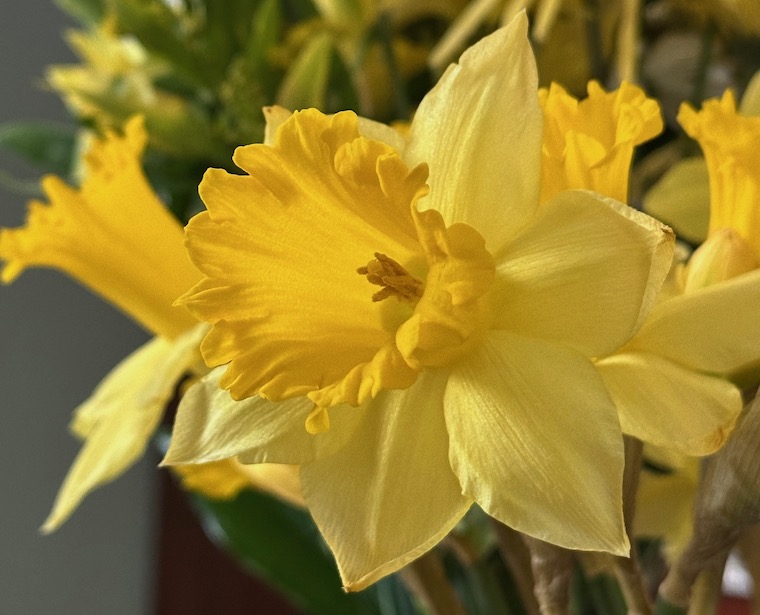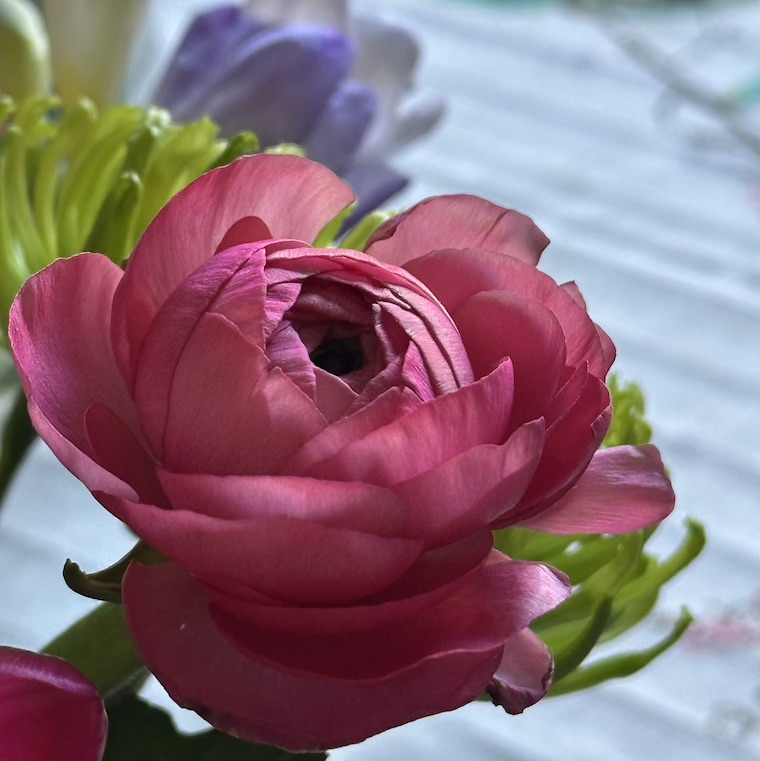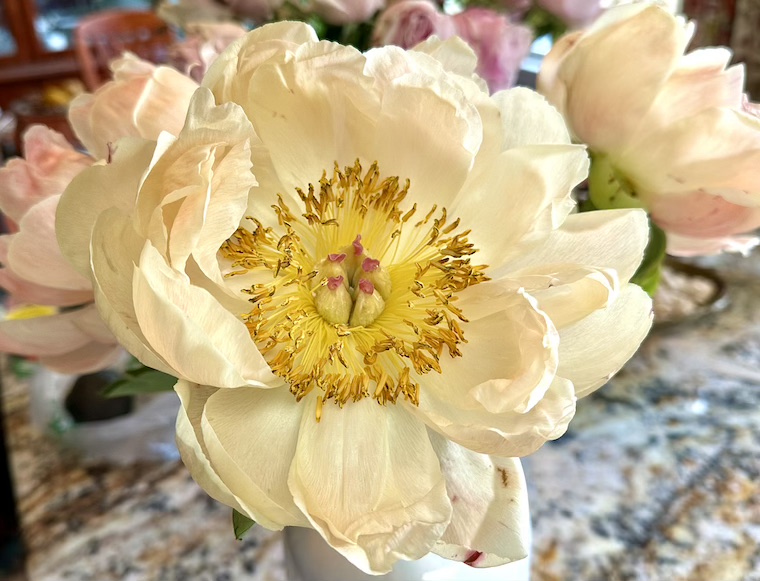Andy has been chomping at the proverbial bit to get the pool open but the weather has not been cooperating for an early season. I’m cooling myself with glimpses at the spring bulb blooms that have been populating markets the past few weeks. It will have to do for now.
Category Archives: Flowers
April
2025
February
2025
Shallow Dish, Deep Reward
Even the most careful and fastidious among us can lose a bloom in the course of arranging a flower bouquet. When that happens, rather than toss it into the garbage, I’ll seek out a shallow bowl or dish on which to display the bloom. My heart always bleeds a bit for those wayward flowers that get beheaded before they have time to fully open up.
Here, a chrysanthemum flower – architectural stunner on its own, even bereft of stem – forms its own little bouquet, and at a perfect scope for a dinner party where no one wants to talk over or around a pesky arrangement.
February
2025
A Pause, and Pose, for Narcissism
The happy visage of bright yellow jonquils has arrived in the local markets – a sure sign of spring on the not-too-distant horizon. With temperatures soaring into the 40’s, perhaps we are finally headed away from this frozen winter. It’s been a long and trying one, with nary a thaw or break in its icy edge. And of course it’s not quite over.
Seeing us through the final weeks of cold and ice, these Narcissus blooms remind of cheerful vanity, string their poses and emitting their fine delicate fragrance. Tom Ford once tried to capture this delicious aroma, and failed miserably.
They won’t be caught and trapped in a bottle.
February
2025
February Flowers
We are but one month away from spring, meaning there is only one more month left of winter. Getting two-thirds of a way through something means the end is in sight – distant sight perhaps, but in sight nonetheless. That said, in the case of winter it’s always this last trudge that feels the bleakest and most difficult. Nerves are frayed, patience is at an end, and even the magic of a snowstorm doesn’t seem so magical when you’ve already done it as much as we have this past year. I find ways of coping in splurging on a bouquet of fresh flowers, then watching as the light shifts during the day, illuminating different hues and colors as the hours tick by. I won’t disturb your viewing pleasure with these pesky words any longer.
February
2025
A Candlelight Dinner
“We don’t ask a flower any special reason for its existence. We just look at it and are able to accept it as being something different for ourselves.” ~ Gwendolyn Brooks
The winter blues are best dispelled through strategic use of candlelight, flowers and an invitation to friends for an informal dinner party. Freshly-inspired by my very first viewing of ‘Babette’s Feast’ I am currently all about a fancy dinner – mostly just in the way of candlelight, because Andy will be crafting a simple Italian meal of basic staples for tonight’s festivities, and I’ve already indicated on the invitation that dress is entirely casual.
“You’re only here for a short visit. Don’t hurry, don’t worry. And be sure to smell the flowers along the way.” ~ Walter Hagen
We do have some crystal stemware that Andy had from before I ever knew him, which sparkles majestically in candlelight, and some small bouquets of pink anemone and purple freesia (all due apologies to Miranda Priestley for the latter) to brighten the winter evening. As with most dinner parties, atmosphere and cutlery and outfits are always less important than guest selection, and with Sherri, Skip, Maria and Kato, it’s already a happy success.
“I’d rather have roses on my table than diamonds on my neck.” ~ Emma Goldman
January
2025
Sex in the Greenhouse
There are things that you guess and things that you know…
Every greenhouse keeps a store of sexual secrets inside its sweaty glass walls, at slight odds with the way flowers so flagrantly flaunt their sexual activities. For those attuned to every protuberance and emission of pollen, reproduction is around every corner, and in every crack and crevice of a greenhouse is the possibility of propagation.
A song about sex then, one that has come before but is given new life here.
There’s little things you hide and little things that you show…
Most flowering plants are monoecious, meaning they contains both female and male elements, so that they can procreate on their own. No need to get into the science of it all – that always waters down the sexual energy buzzing in the greenhouse air. Better to let the floral fantasies unwind, unfettered by fact and technical terms.
I said I won’t tease you, won’t tell you no lies…
Amid an endless winter, a greenhouse provides greenery and life – pulsating, pumping, refusing-to-be-pushed-down life. You can almost feel the fluids flowing through the stems and leaves, filling the veins and throbbing through each unfurling flower.
It’s playing on my mindIt’s dancing on my soul…
Bulges of buds, swelling and bursting, some with color, some with fragrance, some with sturdy erect form, some drooping and hanging limply in extravagant splendor. There is sex around every corner, waiting to be grabbed, wanting to be bent over, needing to be opened and filled and hit like a truck…
It’s naturalIt’s chemicalIt’s logicalHabitualIt’s sensualBut most of all…
Bumping against each other in the slightest humid breeze, or in clandestine meetings behind the veil of night, flowers will have their fun for survival.
January
2025
An Old Beauty Returns
Perhaps sensing our celebration of all things nostalgic this year, and our continued lamentation on winter, this little orchid decided to gift us a few blooms while the wind and snow raged just outside the window. I’d noticed its bud bumps a few weeks ago, and hoped it would save the blooms for when we needed them most, and it did. There is something soul-enriching that happens when you are lucky enough to enjoy an orchid just a few feet from a snow-clad scene.
I’ve noticed the same enchanting perfume from the blooms as the last time it put on a show; at varying times in the day it releases this sweetness, as if it selectively choosing when to emit such beauty, teasing and hiding when it feels like it, pulling back when the world feels too thirsty. As someone who’s been accused, quite accurately, of being a coquettish tease, I admire such silliness.
More than admiration, I have an appreciation for an orchid that sees fit to come into bloom at the very bottom of our winter doldrums. There’s a certain grace in that, a gift in these dark days – something to keep us going until the first hints of spring arrive.
December
2024
A Winter Rose
One of my favorite plants may be in outside bloom in some parts of the world. The winter rose, usually referred to as the Lenten rose or Christmas rose in these posts, has been seen blooming in Boston in milder Decembers. I’m not sure this has been one of those Decembers, as I have’t seen it on recent city explorations, and the blooms seen here are from a display in Trader Joe’s. It matters not – beauty is beauty, whether natural or forced – each has its charms.
Right now, the bulk of our flowers will be found in forced form, unnaturally in bloom at this mostly inhospitable time of the year. In some respects they are more precious and important now than when they come into bloom outside when spring first arrives. That’s what I mean by beauty is beauty.
December
2024
Spray It, Don’t Say It
A simple bouquet of spray roses – pink, as Andy prefers his flowers – is a bright spot as we approach the longest night of the year. These photos were taken in the early morning light – later I’ll post their dramatically different hue at night.
I’ve found that one way to ensure that roses open up is to cut them immediately before plopping them into water so there is no time for the stem to seal up and hinder water flow later – as well as using the hottest water that comes out of the faucet (and no hotter, so you don’t need to boil anything on the stove).
Andy used to grow magnificent roses at his former house, where he had sun and good circulation and the summers were kinder than they’ve been of late. As we get older, there is less interest in sustaining such high-maintenance performers for a few flowers, though from time to time we try out a rose just to see if the climate has improved. Thus far it’s only gotten worse, with the blackspot and humidity and aphid infestations.
For now, these bouquet will have to do – and the bonus is that they’re available year-round whenever we need a little lift of spirits, even in the month of Christmas.
November
2024
Holiday Progeny
Many years and many offices ago, a co-worker gave me a Christmas cactus. It was a small thing in a three-inch pot, wrapped in gaudy ribbon and sprinkled with glitter. Once I got it home, I promptly threw out the wrapping and washed off the glitter, then left it in our front window, which gets the most sun. There it sat for many years, and I’d always more or less forget about it (the best sort of treatment for a Christmas cactus actually) until it caught my eye with this grand electrifying color. Left in a relatively unused room, as our living room tends to be at night, it was able to follow the natural cycle of day sunlight, and every year around this time it would burst into bloom.
Some years it was more floriferous than others, but there were always a few blooms guaranteed, even if the thing was bizarrely changeable. The original plant grew as I repotted it, and it remains in my care to this day. Several months ago, a couple of larger pieces broke off, and I let them dry and callous off, then managed to root them in some light soil. (These are not technically true cacti, but epiphytes, so their soil should be as light as possible – they also seem to like more humidity than a typical cactus.)
Sooner than expected, it produced these blooms – a happy gift that came a little early for Christmas, so maybe this is a Thanksgiving non-cactus after all. I’m not into debating these days, so whatever you want to consider it is fine. Something this pretty defies labels anyway – even proper ones.
November
2024
A Magical Flower from a Magical Man
We hadn’t planned on having flowers at our wedding ceremony, but when Suzie showed up with a bouquet of peonies for the day it was the perfectly serendipitous accent that has since come to symbolize that happy event. We return to them every May, and whenever they bloom in the garden they evoke wonderful memories. Given the sorry state of the world right now, I’ve been bringing Andy a couple of bouquets of roses – a reminder that there is still beauty to be found, and there is still love no matter what else is happening.
He brought me a bouquet of peonies – a trio of large pink blooms that promptly began opening, even in the middle of the night, as soon as I put them in some warm water. They were not the fully double pom-pom versions that are ubiquitous in old-fashioned gardens. These were more delicate, and what they lacked in petal count and fragrance they more than made up for in other ways.
The next morning, they were open completely, and the deep pink hue had softened to a softer pastel color – even more delicate and elegant than the bombastic shade they first showed off. This was where the magic began – as the hours went by, and it actually happened that quickly, the transformation became more profound and beautiful.
As shades of pink drained from the petals, they took on a creamy glow, almost translucent in the light. And then the last part of the show began, as the petals took on a deeper shade of yellow, echoing the golden stems of their stamens. A truly magical performance, courtesy of a magical man. Andy’s been saddened and worried about the likely effect that this election will have on the federal recognition of our marriage, but I reminded him that we were together for ten years before it was legal anywhere, and we would be ok again. Legal terms, papers, and even flowers fade and wither, but love can never be destroyed.
November
2024
A Late Recompense of Floral Color
With a few hard frosts already under our autumn belt, I assumed that our outside blooms were long over. It was a happy surprise when I discovered in a hidden section of our back porch, these fuchsia and begonia flowers, still intact and still in bloom. The immediately brought me back to early summer, when the season was fresh and new, and hope seeped out of every living thing. It was the start of our beautiful coquette summer, and life was a beautiful pink gingham fantasy.
It feels far away, but it was only a few months, and in that same span of time we’ll be returning to spring next year. In spite of several hard frosts, this fall has been remarkably kind, weather-wise. It’s stayed warm – so much so that Andy was swimming on Halloween – something that has never happened before – and the pool is still open with a possibility of one more dip today or tomorrow. We’ve already made a deep dent into fall, and it hasn’t really felt like it – may that mean a swift move through winter as well. We can slow things down again in the spring.
October
2024
A Last Floral Dance?
At the time that I write this, it is past the nine o’clock evening hour. A hard frost has been forecast for tomorrow (today as you’re reading this), and after a day of Andy and I sneezing from allergies, I hope it takes out everything in its path. It’s time. The day hinted at colder things to come, as Andy came in chilled from a final attempt at salvaging one more pool day if it warms up next week. I captured a few final blossoms as seen here, already slightly mottled from the cool nights, and likely to be gone by tomorrow. You may be witnessing what has already departed. Ghostly apparitions befitting the season.
A rare moment bordering on regret, perhaps? I wonder if I should have spent more time with these begonias. They did pretty well in a season that found usual stalwarts struggling. Hidden by a pink curtain and located behind showier and taller pots of papyrus and elephant’s ear, these begonias were paired with a red fuchsia – and both performed admirably when I thought to take in their beauty. I wish I’d thought more.
September
2024
Neon Ghost
These past few weeks I haven’t been outside as much as I should have been. We’ve had some wonderful weather, but when the heart feels downtrodden a sunny day doesn’t much matter. When last I made a studied inspection of the garden, this pink petunia was throwing its vibrant neon blooms face-up to the sun. On a recent walk, I noticed all the blooms had gone, and all the stems and eaves had turned brown. With the sun comes a dryness that has taken the last efforts of the annuals.
Now these flowers are like little neon ghosts, happy to haunt us until the summer comes again.
September
2024
Brightening up the Fade-to-Black Fall
Boston’s bright and bountiful beauty shines in these flower photos, taken on a rainy day and proving that sometimes a gray sky and drops of rain can add to the beauty of the world. I’ve long maintained that the colors in the garden seem stronger and more saturated now than at any other time of the year. Recompense for having to slip into the winter slumber perhaps.
They also provide a lovely little break from the darkness that’s been posted here of late (and which has only just begun, I’m afraid to say). Contrast is vital, and dwelling in the dark for too long has never done anyone any good. Here we have a clematis, a butterfly bush, and some ruby leaves of the Judas tree.




















































